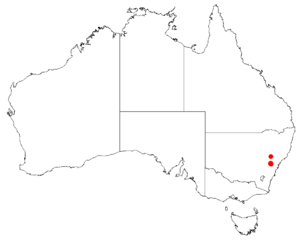Persoonia hindii facts for kids
Quick facts for kids Persoonia hindii |
|
|---|---|
| Scientific classification | |
| Genus: |
Persoonia
|
| Species: |
hindii
|
 |
|
| Occurrence data from Australasian Virtual Herbarium | |
Persoonia hindii is a special plant that belongs to the Proteaceae family. It's a type of shrub, which is a bushy plant. You can only find this plant in a small part of New South Wales, near a town called Lithgow. It grows from an underground stem, and its leaves are long and thin, a bit like needles, and they feel juicy. When it blooms, it has beautiful deep yellow flowers.
Contents
What it Looks Like
Persoonia hindii is a shrub that can stand straight up or spread out. It has many stems that grow from an underground part called a stolon. This stolon is usually about 5 centimetres (2 inches) deep in the ground. The stems can grow to be between 0.3 and 1.0 metre (1 to 3 feet) tall. Older stems have smooth, grey bark. Younger stems are often a dull red colour and are covered with soft, grey hairs.
Its leaves grow one after another along the stem. They are long and thin, like a line or a small rectangle. Most leaves are about 15 to 27 millimetres (0.6 to 1.1 inches) long and 1 to 2 millimetres (0.04 to 0.08 inches) wide. They are juicy, which means they are succulent, and they are almost round when you look at them from the side. Young leaves have a few hairs, but they become smooth as they get older.
Flowers and Fruit
The flowers of Persoonia hindii grow either by themselves or in small groups of up to thirteen. They appear where a leaf meets the stem, or at the very end of a branch. Each flower has a small, scale-like leaf at its base.
Each flower sits on a hairy, dull red stalk called a pedicel, which is about 2.5 to 5 millimetres (0.10 to 0.20 inches) long. The flower has four hairy parts called tepals, which are like petals and sepals combined. These tepals are 12 to 15 millimetres (0.47 to 0.59 inches) long. They are joined together at the bottom, but their tips curl back.
In the middle of the flower, there is a central part called a style. This style is surrounded by four yellow parts called anthers. These anthers are also joined at their base, and their tips curl back. This makes the flower look like a cross when you view it from the end. The part of the flower that will become the fruit, called the ovary, is smooth.
Persoonia hindii usually flowers from January to March. After the flowers, the plant produces fruit. These fruits are dull green and are a type of drupe, which means they have a hard pit inside, like a peach. They are about 8 to 9.5 millimetres (0.31 to 0.37 inches) long and about 6 millimetres (0.24 inches) wide.
How it Got its Name
The plant Persoonia hindii was officially described for the first time in 1997. This was done by two scientists, Peter Weston and Lawrie Johnson. They studied a plant sample that was found in the Newnes State Forest. Their description was published in a science journal called Telopea.
The second part of the plant's name, hindii, was chosen to honour Peter Hind. He was the first person to collect a sample of this specific plant back in 1989.
Where it Lives
This special Persoonia plant is only found in the Newnes State Forest. Scientists know of only nine places where it grows. In each of these places, there might be just one plant or a small group of them. It grows in forests and woodlands where Eucalyptus trees are common.
Protecting the Plant
Persoonia hindii is considered an "Endangered" species. This means it is at a high risk of disappearing forever. It faces several dangers, such as:
- Activities like logging, which can change its habitat.
- Mining for sand, which can also destroy the places where it grows.
- Fires that happen too often can harm the plants.
Because of these threats, the New South Wales Government has listed Persoonia hindii as "Endangered" under their Biodiversity Conservation Act 2016. This law helps protect plants and animals that are in danger.

